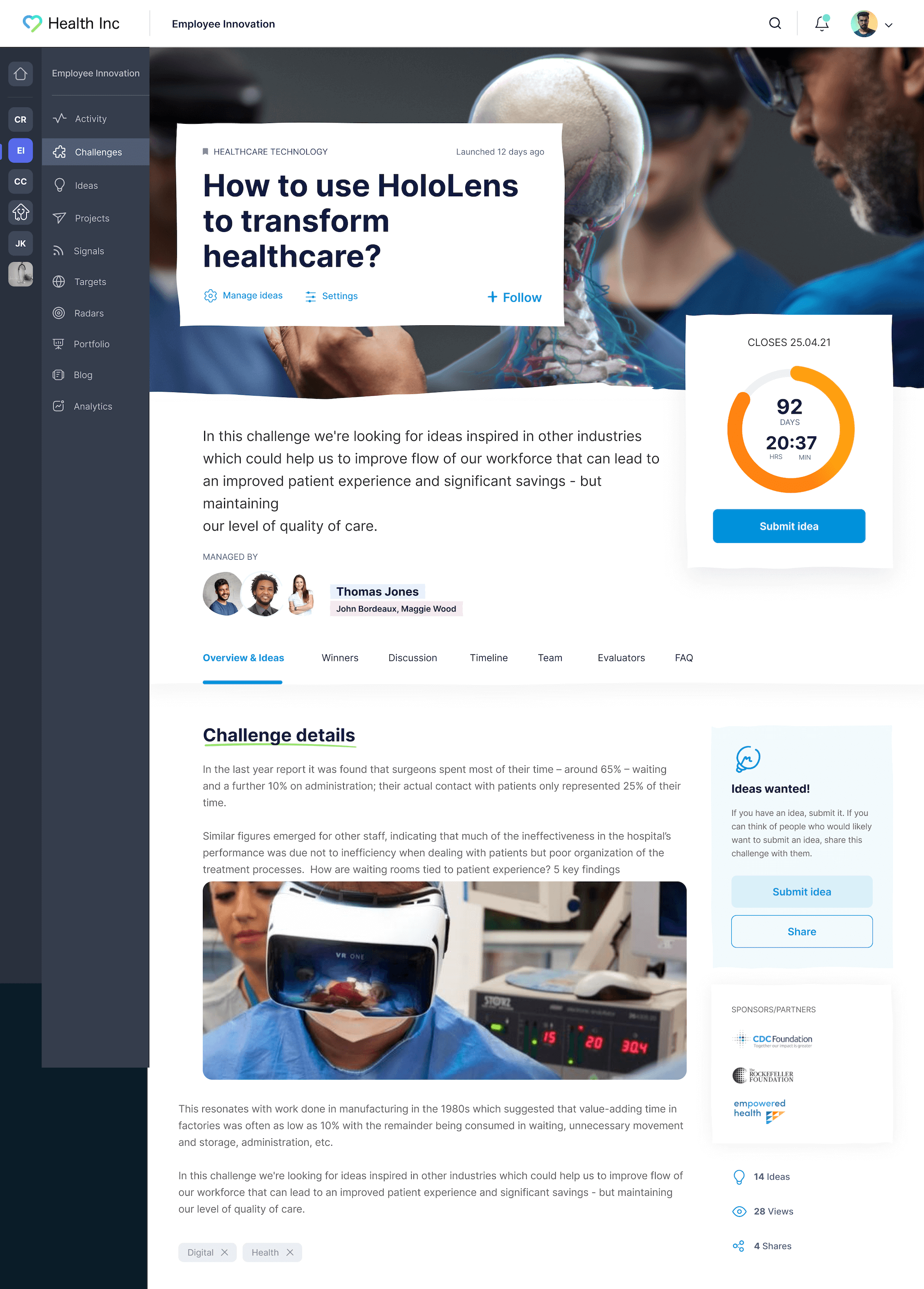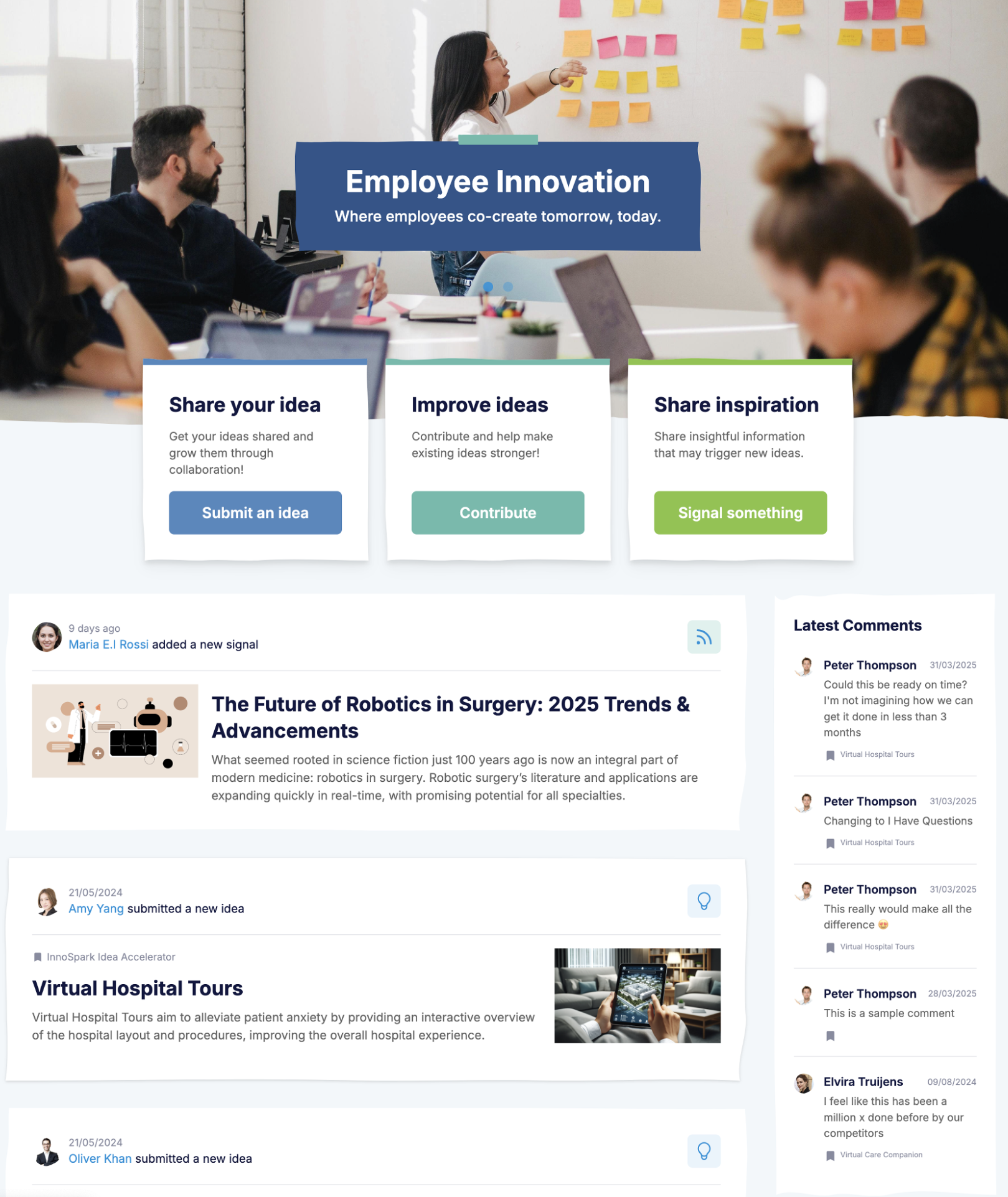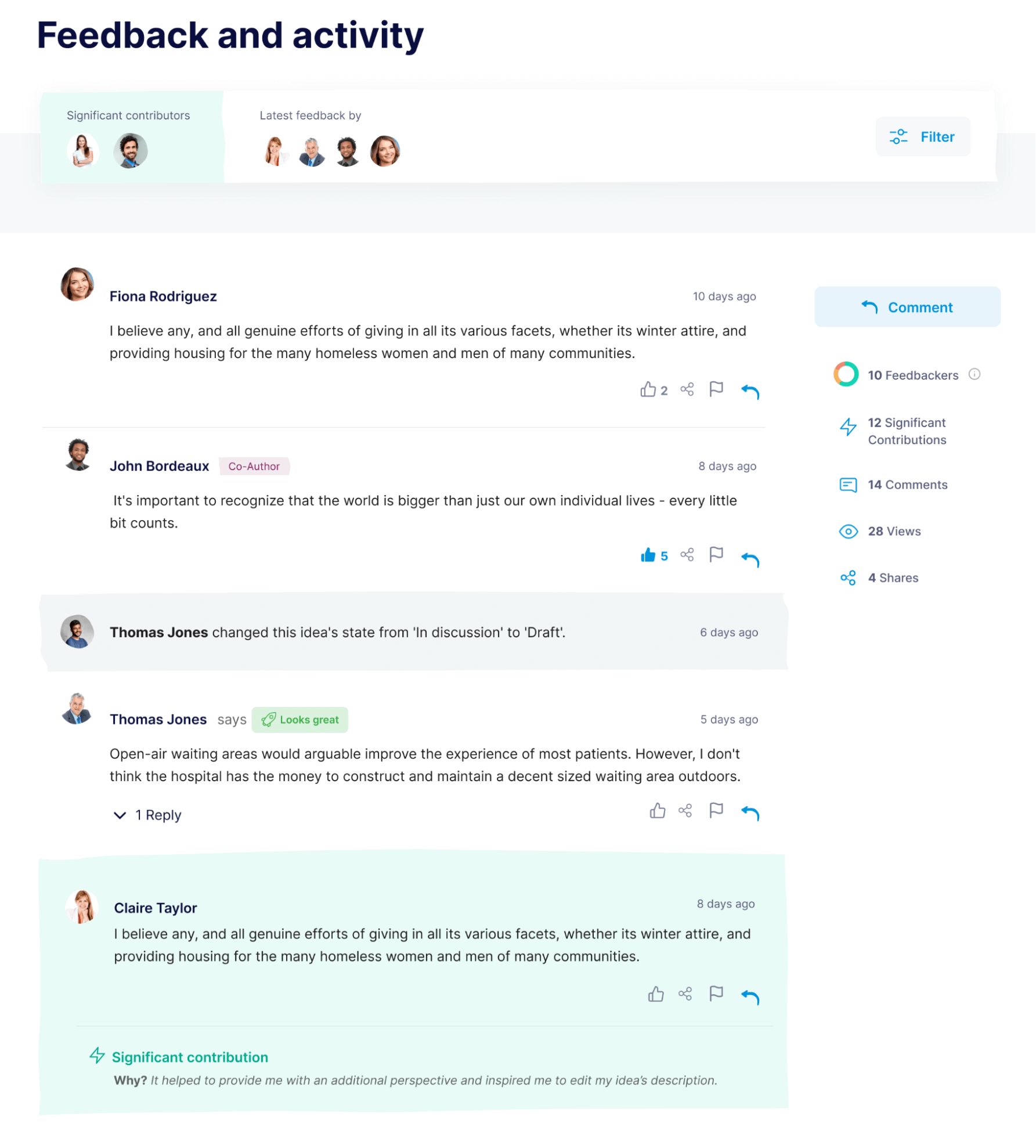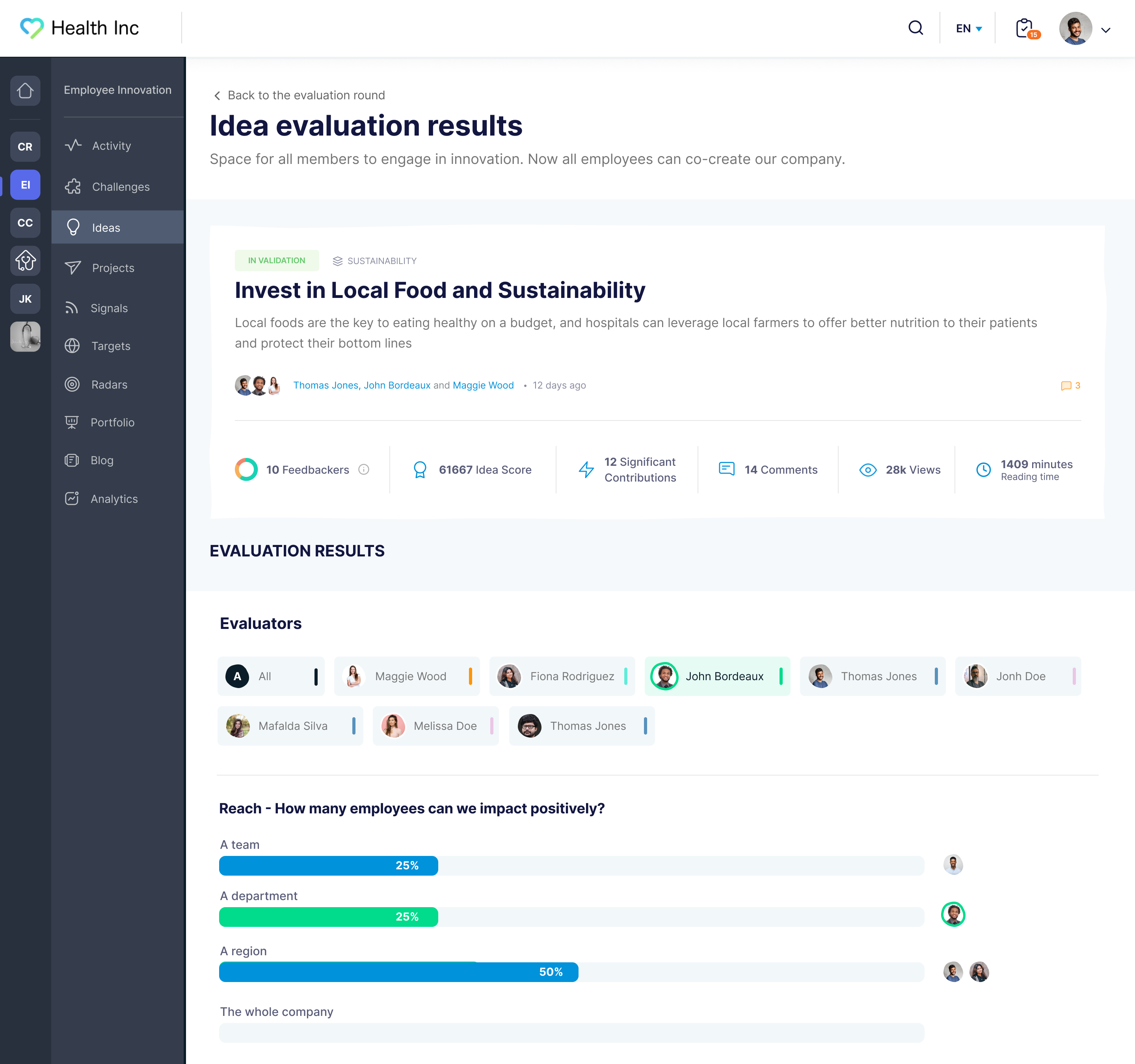Managing technological innovation means surfacing ideas for new technologies and continuous improvements, testing and de-risking them, and turning them into real-world applications.
Establishing the right systems and tools to manage technological innovation at scale can help companies increase revenue, cut costs, gain a competitive advantage, and avoid being blindsided by disruptive innovation.
Here’s the methodology we’ve used over the last 15+ years to manage technological innovation inside enterprises, startups, government agencies, and academic institutions alike:
Collect high-quality ideas: Companies should start by gathering ideas for product development and continuous technology improvements. This uncovers growth opportunities and flags threats to the business model.
Refine ideas using the entire workforce's expertise: Complex technological ideas require multiple competencies co-creating to reach a final outcome. In most cases, the final idea is entirely different from the first draft. As a result, we recommend enabling all employees to view ideas and co-create with the idea authors to improve them.
Have subject matter experts evaluate ideas: Improvements to the company’s existing offerings involve little risk since the idea requires few resources. If it fails, it's possible to revert to earlier methods. Because of this, experimentation is typically not needed, and subject matter experts can simply score ideas on a scorecard.
Reduce risk in ideas: New technologies carry higher uncertainty and risk, call for significant resources, and cannot be evaluated using a scorecard; there is no data to support them. Something like this has never been done before. We advise reducing risk in ideas through systematic experimentation before implementing them.
Implement ideas: Once the risk is reduced to an acceptable level — meaning the company is confident in demand, profitability, and its ability to build the solution — the project management office (PMO) implements the idea and innovation teams measure results and continue making improvements over time.
In this article, we discuss each step in detail — including what we’ve seen work well, common pitfalls to avoid, and how our innovation management software, InnovationCast, helps companies manage this process across hundreds of projects.
Schedule a 25-minute demo to learn how InnovationCast can enable you to manage technological innovation at scale.
Step 1: Call on Employees & Outside Innovators to Share their Best Ideas
Collecting high-quality ideas is the foundation of managing technological innovation. Ideas help companies identify opportunities to innovate with new technologies and improve their current offerings.
Without ideas, there’s no technological innovation.
A popular approach companies use to collect ideas is to ask employees and outside innovation participants, such as customers, startups, and researchers, to share their insights. This crowdsourcing strategy leverages the expertise and perspectives of hundreds of individuals, leading to better ideas than brainstorming sessions where only a few employees can contribute.
While we advocate for crowdsourcing ideas, we’ve seen companies make critical mistakes that hinder their ability to engage innovation participants.
Typically, companies try to collect ideas by creating a webpage, setting up an email address, or launching a Slack channel and asking employees to contribute.
We’ve coined this the “digital suggestion box,” and it has multiple problems:
Companies fail to gather relevant ideas because their suggestion box doesn’t give employees the context needed to understand company priorities and objectives. That leads to irrelevant ideas getting rejected, frustrations piling up, and employees eventually stopping sharing altogether.
Employees think the company isn’t serious about innovation. They’ve seen countless suggestion boxes launched without real follow-through. So, they figure this time’s no different — and their ideas won’t spark any action. That’s why they don’t bother submitting ideas.
Employees don’t think their ideas are valuable. Through surveys and interviews, we’ve learned that many don’t consider their ideas revolutionary enough or believe the company only wants ideas from engineers. They don’t realize that small improvements are the backbone of technological innovation. The end result is that they don’t participate in innovation.
Instead of setting up a context-free Slack channel or web page, we’ve found it’s way more effective to educate employees on the value of their contributions and clearly communicate the topics the company is seeking ideas on.
That’s why we built InnovationCast — to help companies engage their workforce and source high-quality ideas.
How InnovationCast Helps Engage a High Volume of Employees
InnovationCast includes training resources that educate employees on the value of their ideas and bust the myth that small, continuous improvements don’t matter.
These resources are what allowed our clients such as DHL and Novo Nordisk to engage thousands of employees in under four weeks.
We were intentional with how we designed these educational resources. Our innovation management software automatically sends users quick, digestible snippets they can absorb in minutes — no need to set aside a whole day to learn about innovation.
Additionally, companies can use Innovation Challenges to focus ideation on their current areas of interest.
Innovation Challenges are posts that contain extensive context around the company’s priorities (e.g., improve sustainability, strengthen competitiveness, expand into new markets).
When a new challenge is launched, InnovationCast alerts employees and asks them to review the information inside and submit ideas.

Innovation Challenges have three advantages over regular suggestion boxes:
Companies collect more relevant ideas: Employees can use resources within the Innovation Challenge — videos, articles, and case studies — to guide their ideation efforts. This leads to higher-quality, goal-aligned submissions and boosts morale.
Employees gain visibility into how their ideas are being worked on: When someone shares an idea, they can track its progress in the InnovationCast dashboard — whether it’s under evaluation, in validation, or moving into implementation. Their input isn’t being ignored, which shows the company is serious about taking action.
Challenges are time-bound: We recommend setting deadlines to create urgency and focus. It nudges employees to act quickly and keeps innovation top of mind. Unlike a suggestion box, new challenges can be launched anytime priorities shift.
In addition to crowdsourcing, InnovationCast has startup and technology scouting features that companies can use to gather proposals directly from startups. Our pre-built network of startups learns your priorities and submits customized proposals showcasing how their technology can help.
Step 2: Refine Ideas Using the Intelligence of the Entire Workforce
Once companies have collected technological ideas, they often move straight to evaluation or validation.
However, we don’t recommend evaluating or validating raw ideas right away, as they’re often incomplete or flawed. Instead, we suggest sending them to a refinement stage, where employees across departments — such as research and development, biotechnology, and healthcare — can view each other's ideas, identify weaknesses, ask tough questions, and collaborate to strengthen them.
There are two benefits to idea refinement:
It improves ideas by tapping into the brainpower of the entire workforce: Technological ideas often need input from multiple competencies that the original author may not have. Idea refinement gives authors the opportunity to improve them with help from colleagues and consider angles they may have missed on their own.
It reduces resource waste: When companies send ideas directly to validation — where discovery teams run experiments to test a new business idea and reduce risk — it often leads to wasted resources. Teams may spend time and money testing aspects that could have been invalidated early by involving a few subject matter experts.
However, idea refinement requires ideas to be stored in one consistent, accessible location — where all employees can access them, see version history, review related conversations that shaped technological changes, and view any associated media.
Companies often struggle with refinement because they manage technological innovation ad hoc, with each team or department using separate tools to collaborate and iterate.
How InnovationCast Helps Companies Refine Ideas and Break Down Departmental Silos
To help companies refine ideas, InnovationCast automatically displays all submissions on the activity feed — making them visible to everyone, regardless of their department.

Employees working in R&D management, finance, marketing, and other departments can help authors refine their ideas — resulting in fully fleshed-out concepts.
InnovationCast encourages collaboration with subtle features like email nudges and voting systems. When employees vote on an idea, they’re asked to provide feedback explaining their vote, and that feedback is shared directly with the idea author.

Idea authors can collaborate with colleagues to refine their ideas. All edits, conversations, and shared media are saved for future reference, so innovation managers and stakeholders see how an idea evolves over time.
Idea authors can also tag any feedback as a “Significant Contribution,” rewarding co-creators for their effort and highlighting which input had the biggest impact on the idea.

Step 3: Evaluate Ideas and Prioritize the Most Impactful Ones
Once companies gather high-quality ideas, the next steps depend on each idea's risk level:
Continuous improvement ideas — those enhancing existing technology functionality — move to evaluation.
Higher-risk initiatives, like new technology concepts, proceed to step four: validation.
Continuous improvement ideas carry less risk because they have strong justification and require fewer resources than new technology projects.
For example, the customer success team might already know 50 customers want an offline access feature and are willing to pay more.
Because continuous improvement ideas are low-risk, evaluators use scorecards to assess them. These scorecards include questions about demand, feasibility, impact, and more. Evaluators review the information provided by the idea author and score each question from 1 to 10.
Ideas that meet the baseline score move to implementation, with stakeholders prioritizing the highest-scoring ideas first.
While evaluation may seem straightforward, many companies fail to give evaluators enough guidance. Left to use their own methods, evaluators risk making inconsistent assessments, biased judgments, and overlooking truly valuable ideas.
Instead, companies should structure evaluation by clearly defining what data to consider, who to involve, and when to send ideas back for refinement. This guidance naturally depends on the idea’s scope and characteristics.
InnovationCast Workflows Guide the Evaluation Process
Companies can invite evaluators to join InnovationCast, where they’ll see a clear list of all ideas requiring their review. InnovationCast then recommends tailored workflows evaluators can use to score each idea.
These workflows outline which scorecards and evaluation models to use, what data points to consider, and which benchmarks to reference. This guidance varies depending on the idea.
During onboarding, we configure these workflows around your business strategy and management process.

After evaluators approve ideas, InnovationCast automatically notifies key stakeholders, prompts them to analyze all greenlit ideas, and allows them to vote on prioritization.

Read more: 6 Steps from Idea to Implementation: The Innovation Process
Step 4: Validate and Reduce Risk in the Idea
As mentioned earlier, new technology ideas are inherently risky. The company has never pursued anything like them, and full-scale implementation could cost hundreds of thousands — if not millions — of dollars.
If the idea succeeds, the upside is massive. But if things go wrong, the consequences can be costly.
Evaluators can’t rely on a simple scorecard to assess high-risk, disruptive ideas. The information needed for informed decision-making, such as customer demand, technical feasibility, and profitability, often doesn’t exist yet.
That’s why validation is necessary. Idea validation means running experiments to gather the data needed to reduce risk and build confidence that the idea is worth implementing.
When validating ideas, companies usually form discovery teams to reduce risk. These teams identify the biggest risks and run experiments to gather insights and lower uncertainty.
We won't cover validation in detail, but check out our article on idea validation.
Our main takeaway: Guide discovery teams on how to validate ideas.
All too often, companies leave discovery teams to manage validation on their own. But these employees aren’t innovation professionals — they rarely know assumption mapping, how to pick the right experiments, or how to identify key risk indicators. Without guidance, discovery teams take a shot in the dark, wasting resources and killing promising ideas.
Instead, innovation departments should create clear workflows that guide discovery teams through validation step-by-step, leaving no room for guesswork.
Read more: How to Develop an Innovation Process to Launch New Ideas
InnovationCast Workflows Structure the Idea Validation Process
Companies use our workflows to guide discovery teams across all departments in managing innovation projects. These workflows cover everything needed to reduce risk.
They help teams map assumptions, select the most effective tests, identify key risk indicators, and manage intellectual property. Tools like assumption mapping templates, learning logs, validation planning boards, and prioritization matrices keep validation sharp, coordinated, and on track.

Naturally, different ideas require different validation steps, so we offer tailored workflows for continuous improvements, revolutionary innovations, new product development, artificial intelligence ideas, and more.
During onboarding, we'll learn about your priorities and innovation strategy and build workflows around them. As your validation process evolves, you can always adjust these workflows.
The discovery team lead assigns each task to a specific team member — for example, customer research to marketing and prototyping to engineering.
When a task is completed, InnovationCast automatically notifies the next person in line, prompting them to start their part.
Step 5: Implement Ideas, Continue Learning & Drive Technological Advancements
Once risk and uncertainty are reduced and stakeholders decide to greenlight implementation, the PMO takes over — planning implementation and commercialization. They create a detailed roadmap, assign responsibilities, and monitor progress against milestones.
While technology development is the PMO’s responsibility, innovation personnel should remain involved post-implementation. They should track metrics like adoption rates, market share, and customer satisfaction scores, gathering insights through customer surveys and interviews.
Based on this feedback, innovation teams should incrementally improve the technology.
InnovationCast’s Reporting Dashboard Helps Innovation Teams Track Technologies Post-Implementation
Innovation teams can connect InnovationCast’s reporting dashboard to any data visualization tool to measure KPIs and risk indicators post-implementation. These include:
Adoption rate
User satisfaction score
Performance metrics
Error rate or bug count
Time to full adoption
Process efficiency gains
Training completion rate
Having all necessary data in one reporting dashboard lets innovation teams and stakeholders quickly see which innovations are meeting expectations, which are falling short, and what learnings teams are gathering.
They can then decide whether to keep funding or focus on improvements.
This transparency is key to securing future innovation budgets — stakeholders get clear ROI insights without juggling multiple tools.
Organize the Management of Technological Innovation at Scale with InnovationCast
Get started with a free demo and learn how InnovationCast can help you manage technological innovation within your organization.

